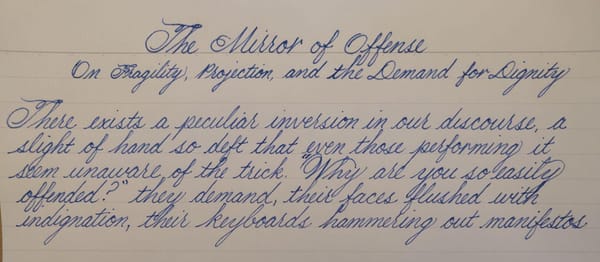Dutch Masters to Puberty Blockers

The Intellectual Acrobatics of Daniel Howard James
Every so often in the ongoing discourse around transgender healthcare, something comes along that’s so peculiar it demands attention - not because it’s persuasive, but because it represents a fascinating case study in how rhetoric can substitute for substance. Daniel Howard James’ recent Genspect article, “Puberty Blockers: Creating a Blank Canvas for the Surgeon-Artist,” is exactly that kind of curiosity.
It’s a piece so intellectually tortured that reading it feels like watching someone try to connect quantum physics to breakfast cereal while insisting there’s a profound point somewhere in the mess.
If this is so bad, why cover this particular article? Because it exemplifies a troubling trend: as medical evidence increasingly supports gender-affirming care, and as critics are retreating into increasingly abstract philosophical and metaphorical territories while trying to leverage these positions to advance political goals and ideology. Rather than engaging with peer-reviewed research or clinical outcomes, they construct elaborate conceptual frameworks that sound intellectual but crumble under scrutiny.
Understanding how these arguments work - and why they fail - matters. Parents, policy makers, and concerned citizens deserve to see the difference between substantive critique and what I can only describe as intellectual sleight-of-hand.
So let’s talk about James’ article. It’s a piece so intellectually tortured that reading it feels like watching someone try to connect quantum physics to breakfast cereal while insisting there’s a profound point somewhere in the mess.
Unpacking the Metaphorical House of Cards
James constructs an elaborate metaphorical framework that attempts to connect Dutch art history to transgender healthcare. Yeah, I had a hard time writing that sentence, now imagine reading his entire article. So let’s get started and begin untangling this convoluted web:
The Vermeer/Simulacra Framework
James begins with Dutch paintings, then invokes Baudrillard’s concept of ‘simulacra’ (representations of representations, not reality). The implicit argument is that trans women are like representations of paintings - not based on ‘real’ womanhood but on cultural representations of womanhood. It’s an attempt to philosophically de-legitimize transgender identity by framing it as both artificial and derivative.
This goes, in essence:
- ‘Real women’ exist in reality
- Paintings of women are representations of reality (one step removed)
- Trans women are like representations of paintings (two steps removed)
- not based on ‘real’ womanhood but on cultural representations of womanhood
- Therefore, trans women are ‘simulacra’ - copies without originals
The Merchant/Parent Parallel
From here, James makes a jarring leap: ‘The affluent Dutch of the 17th century wanted to capture their daughters’ beauty by investing in the very best paintings… Today, parents invest in their children’s bodies to turn daughters into sons, and their sons into daughters.’ This false equivalence between art patronage and supporting transgender children attempts to re-frame medical care as a luxury consumer good.
The Blank Canvas Metaphor
Building on this consumer framework, James introduces their core metaphor: puberty blockers supposedly ‘erase’ natural development (creating a ‘blank canvas’) so that gender-affirming surgeries can ‘paint’ a new picture, supposedly for aesthetic perfection rather than medical necessity. The implication is that gender-affirming care is about art, not medicine - about appearance, not alleviating suffering.
- Natural puberty creates a body with sex characteristics (a ‘painted canvas’)
- Puberty blockers ‘erase’ this natural development (creating a ‘blank canvas’)
- Gender-affirming surgeries then ‘paint’ a new picture on this blank canvas
- This is supposedly done for aesthetic perfection, not medical necessity
This framing completely misrepresents the purpose of puberty blockers and gender-affirming care, which is to alleviate gender dysphoria, not create some kind of aesthetic ideal. The Michael Jackson Comparison
The Celebrity Transformation Comparison
To reinforce this aesthetic framing, James then connects Christine Jorgensen and Michael Jackson, suggesting that transgender healthcare is similar to Jackson’s multiple cosmetic procedures - potentially unhealthy or addictive. This deliberately conflates gender dysphoria (distress from gender-body incongruence) with body dysmorphia or cosmetic enhancement.
- Jackson changed his appearance through multiple surgeries
- These changes were potentially unhealthy or addictive
- Therefore, transgender healthcare is similarly unhealthy/addictive
This ignores the fundamental differences between body dysmorphia (never being satisfied with appearance) and gender dysphoria (distress from gender-body incongruence). The former is feeding a machine of never good enough/insecurities and the latter very much has a ‘best I can do’ with a high satisfaction and quality of life afterwards. If you never look beyond the superficial qualities, it makes sense to say these are similar; however, once you listen and learn it becomes very obvious why one cannot be conflated with the other.
The Geographic Guilt-by-Association
Continuing the theme of de-legitimizing medical care as something aesthetic or commercial, James notes: ‘The gender clinic is near Amsterdam’s red light district.’ This creates a subliminal connection between commercialized sexuality and transgender healthcare, further removing it from the realm of legitimate medicine.
And this argument? That’s not even reaching - that’s flailing wildly in the dark after falling down three flights of stairs. By that logic, I could argue that churches are suspicious because many of them are within walking distance of liquor stores. Or that a hospital is suspect because it’s near a casino - completely meaningless but emotionally evocative.
The Matrix Reference
Finally, the article concludes with a reference to ‘The Matrix’ (made by the Wachowski sisters, who are both transgender, though James conveniently doesn’t mention this). This completes the circle: transgender people are living in a ‘false reality’ (like a Baudrillardian simulacrum), and even philosophers would reject this reality.
- Trans people are living in a ‘false reality’ like characters in The Matrix
- Even Baudrillard (whose work influenced the film) rejected the movie
- Therefore, even philosophers would reject transgender identity
It’s circular reasoning wrapped in pop culture references.
Trying To Bring Them Together
What ties these seemingly disparate metaphors together is a consistent effort to re-frame transgender healthcare as:
- Artificial and removed from reality (the simulacra argument)
- Aesthetic rather than medical (the blank canvas argument)
- Commercial rather than therapeutic (the Dutch merchant and red light district connections)
- Potentially harmful or addictive (the Michael Jackson comparison)
- A form of delusion (The Matrix reference)
What makes these metaphors so tortured is that they don’t connect logically - they connect emotionally and associatively. James isn’t making a coherent argument; they’re creating a collage of negative associations around transgender healthcare without ever engaging with the actual medical evidence or ethical frameworks relevant to the discussion.
This isn’t just reaching - it’s a deliberate rhetorical strategy to avoid engaging with medical evidence. By framing the entire discussion in terms of art, commerce, and philosophy, James sidesteps the need to address the actual medical literature on gender-affirming care.
The Logical Fallacy Gallery: A Guided Tour
Throughout this metaphorical maze, James deploys several classic logical fallacies:
False Equivalence
The Quote: "The affluent Dutch of the 17th century wanted to capture their daughters' beauty by investing in the very best paintings, at a time when the colony of 'New Amsterdam' was being built on Manhattan Island. Today, parents invest in their children's bodies to turn daughters into sons, and their sons into daughters."
Why It's Fallacious: This creates a false equivalence between art commissioning (a luxury status symbol) and medical treatment for gender dysphoria (healthcare addressing psychological distress). Commissioning portraits was purely aesthetic and status-driven; supporting a child's gender-affirming care is about alleviating documented suffering.
The Counter: Parents supporting transgender children aren't "investing in their children's bodies" for status or aesthetic reasons—they're seeking evidence-based medical care to address their children's psychological distress. Multiple studies show that gender-affirming care improves mental health outcomes, including reduced rates of depression, anxiety, and suicidality.
Red Herring
The Quote: "As Baudrillard defined them in his 1981 book, simulacra are representations not of reality, but of other representations, to the extent that the original is lost. Disneyland is not a copy of an actual medieval European city like Delft..."
Why It's Fallacious: This extensive discussion of Baudrillard and simulacra distracts from the actual medical, psychological, and ethical considerations relevant to gender-affirming care. It introduces a philosophical framework that has nothing to do with the clinical evidence for or against puberty blockers.
The Counter: The efficacy and ethics of puberty blockers should be evaluated based on clinical research, psychological outcomes, and medical ethics—not French postmodern philosophy. The Dutch Protocol was developed based on clinical observation and research with transgender youth, not aesthetic or philosophical considerations.
Appeal to Ridicule
The Quote: "What if the purpose of the Dutch Protocol is not to benefit the patient, but to provide a blank canvas for the surgeon-artist in pursuit of aesthetic perfection? If that sounds psychopathic perhaps it is."
Why It's Fallacious: This ridicules gender-affirming care by portraying medical professionals as "psychopathic" artists rather than clinicians. It's designed to make the treatment sound absurd rather than addressing it on its merits.
The Counter: The Dutch Protocol was developed by endocrinologists, psychiatrists, and psychologists at respected medical institutions with the explicit goal of reducing gender dysphoria and improving psychological outcomes. Its development and implementation are documented in peer-reviewed medical literature, with continuous follow-up studies tracking outcomes.
Guilt by Association
The Quote: "The gender clinic which originated the Dutch Protocol for puberty blockade is within a bicycle ride of Amsterdam's red light district."
Why It's Fallacious: This attempts to taint gender clinics by associating them with sex work, despite there being no causal or meaningful connection between the two. Geographic proximity implies nothing about the nature or validity of medical care.
The Counter: By this logic, we could discredit any institution based on what happens to be nearby. Amsterdam's VU University Medical Center is a respected academic medical institution that follows evidence-based protocols. Its location has no bearing on the validity of its medical practices. The Center for Expertise on Gender Dysphoria follows rigorous assessment protocols and publishes its research in peer-reviewed journals.
Quote Mining
The Quote: James quotes Sarah Mittermaier a.k.a. Eliza Mondegreen saying: "Medical providers and patients alike are under the mistaken and problematic impression that 'transition should lead to improvement.' In reality, researchers and clinicians are seeing 'the persistence of negative affect throughout and beyond GAMT'..."
Why It's Fallacious: This selectively quotes from a larger context to create the misleading impression that researchers believe transition doesn't help patients, and trying to smuggle an accusation as fact through the claim ‘If the patient wants gender transition, that is now considered sufficient by gender clinics, whatever the physical and mental health outcomes.’ In reality, the paper being discussed was exploring how to better measure outcomes beyond simplistic metrics, not suggesting that transition doesn't help.
The Counter: The actual research on gender-affirming care consistently shows improvements in psychological outcomes for appropriately assessed individuals. While no treatment is perfect and some individuals continue to experience challenges, studies show significant reductions in depression, anxiety, and suicidality among those who receive appropriate care.
These rhetorical techniques serve a purpose: they create an impression of intellectual depth while avoiding the need to engage with the substantial body of research supporting gender-affirming care. By focusing on philosophy, art history, and geographic proximity rather than clinical evidence, James constructs an argument that sounds profound but lacks substantive engagement with the actual medical issues at hand.
Furthermore, James is smuggling in a known anti-trans activist as an expert in a field they have no qualifications in. Much like James with this article. In case you don’t know, 'Eliza Mondegreen' is a pseudonym used by Sarah Mittermaier, an anti-transgender activist with no medical credentials who is affiliated with organizations designated as hate groups by the Southern Poverty Law Center. Consider the source.
These rhetorical techniques serve a purpose: they create an impression of intellectual depth while avoiding the need to engage with the substantial body of research supporting gender-affirming care.
The Michael Jackson False Equivalence
The Michael Jackson comparison deserves special attention for its particularly egregious misrepresentation. James writes that Jackson ‘transformed from a young black man to a surgically enhanced, post-racial and trans-feminine adult.’
This conflates racial identity, gender expression, and Jackson’s documented medical conditions (vitiligo and lupus) in a way that shows either profound ignorance or willful misrepresentation. Jackson publicly stated he had vitiligo, a condition causing skin depigmentation, which was confirmed in his autopsy.
Using his appearance changes as a comparison point for transgender healthcare reveals the article’s fundamental intellectual dishonesty. If you need to misrepresent one subject (Jackson) to critique another (transgender healthcare), your argument has already failed.
Cherry-Picking Comments to Support a Narrative
To reinforce the ‘it’s all about aesthetics’ framework, James selectively features YouTube comments about facial feminization surgery:
‘you two look even more alike now and that is a compliment to both of you lol…’ ‘They look so cute next to each other! So obviously sisters!’
This cherry-picking serves a purpose: it reinforces James’ core claim that transgender healthcare is primarily about appearance rather than alleviating dysphoria. But YouTube comments on an influencer’s content are hardly representative of the complex medical, psychological, and personal factors involved in gender transition.
What James conspicuously omits? The extensive research showing improved psychological outcomes with gender-affirming care. The rigorous assessment protocols used by reputable clinics. The fact that most transgender youth who use puberty blockers do so to alleviate documented psychological distress, not to prepare for surgery.
A Review
James’ article isn’t just bad - it’s the intellectual equivalent of a child wearing their parent’s clothes and pretending to go to work. It’s Deepak Chopra explaining quantum physics to a room full of actual physicists. It’s a philosophical soufflé that collapsed before it even made it to the oven.
What we’re seeing is someone who discovered Baudrillard approximately 15 minutes before writing this piece and thought, ‘Yes, THIS is the perfect framework to critique transgender healthcare!’ It’s like watching someone who learned three chords on guitar immediately attempt to play ‘Through the Fire and Flames’ at a talent show.
The metaphorical leaps aren’t just strained; they’ve pulled every logical muscle possible and are now lying in a heap on the floor crying for help.
Dutch paintings → puberty blockers is not a connection that exists in our universe or any adjacent possible world.
And the ‘gender clinic is near Amsterdam’s red light district’ argument? That’s not even reaching - that’s flailing wildly in the dark after falling down three flights of stairs. By that logic, I could argue that churches are suspicious because many of them are within walking distance of liquor stores.
The cherry on top is invoking ‘The Matrix’ at the end - a film made by two transgender women - to criticize transgender healthcare, without a hint of self-awareness or irony. It’s like quoting MLK to argue against civil rights.
If this article were a student paper, it would come back with ‘SEE ME AFTER CLASS’ written in red ink across the top and a strongly worded note about the difference between stringing together impressive-sounding words and making an actual argument.
In short: this isn’t just a bad article - it’s a masterclass in how to sound intellectual while saying absolutely nothing of substance. It’s the written equivalent of an empty suit.
This article exists in that special category of ‘so nonsensical that not even a poorly-trained AI could generate it.’ Most AI systems, even the bad ones, at least attempt to maintain some semblance of logical coherence.
What makes James’ piece so remarkable is that it manages to be simultaneously pretentious AND incoherent - a combination that requires a uniquely human touch. AI might generate word salad or overwrought prose, but rarely both simultaneously with such commitment to the bit.
The truly human element here is the confident incorrectness - the absolute certainty with which James connects dots that exist in entirely different dimensions. An AI would eventually loop back to its training data and stumble onto something factual about gender-affirming care, if only by accident!
This is like those AI-generated scripts that go viral because they’re hilariously off, except James didn’t have the excuse of being trained on a limited dataset. They chose, with full human agency, to write ‘The gender clinic is within bicycle distance of Amsterdam’s red light district’ as if that constituted meaningful analysis.
It’s almost impressive, in its way. Like watching someone confidently drive in the wrong direction while explaining that maps are just a social construct anyway.
Wrapping It Up…
What James has created isn’t thoughtful criticism but what can only charitably be called intellectual cosplay - dressing up in the language and references of academic critique without doing the actual work of scholarship. It’s like someone who’s watched a few YouTube videos about quantum physics trying to explain why their healing crystals work.
The most charitable interpretation is that James got so enamored with their own metaphorical framework that they lost track of making a coherent argument. But I suspect it’s more deliberate than that. This style of writing serves a specific purpose: it gives the appearance of intellectual depth while allowing the author to make inflammatory claims without having to defend them directly.
When James says ‘What if the purpose of the Dutch Protocol is not to benefit the patient, but to provide a blank canvas for the surgeon-artist in pursuit of aesthetic perfection? If that sounds psychopathic perhaps it is,’ they’re essentially accusing medical professionals of psychopathic behavior without having to provide a shred of evidence.
Observe how well this works with pretty much anything:
What if Daniel James is not writing these elaborate metaphorical critiques because they believe in them, but because generating transmisic content pays better than actual scholarship? If that sounds like selling manufactured outrage for profit, perhaps it is.
What if Daniel James has never actually read a single peer-reviewed study on gender-affirming care, but instead constructs elaborate art history metaphors to hide this ignorance? If that sounds intellectually fraudulent, perhaps it is.
What makes James’ approach in his claptrap of an article so insidious is that it can seem impressive to readers who aren’t familiar with the topic or with critical analysis. The name-dropping of Baudrillard, the art history references, and the philosophical vocabulary create an illusion of erudition that masks the absence of substantive argument.
But we can learn something from this: The magnitude of these intellectual contortions reveals something important.when people lack substantive evidence against gender-affirming care, they resort to increasingly tenuous connections and elaborate metaphors. It’s not coincidence that their arguments become more abstract as the scientific evidence for gender-affirming care becomes more concrete.
For those seeking genuine understanding of these complex issues, I’d recommend consulting the actual medical literature rather than articles that make the intellectual leap from Vermeer to puberty blockers with the grace of a rhinoceros attempting contemporary dance.
Remember, when someone has to reach all the way back to 17th century Dutch painting to make a point about modern medicine, they’re not building an argument, they’re constructing a fantasy.


